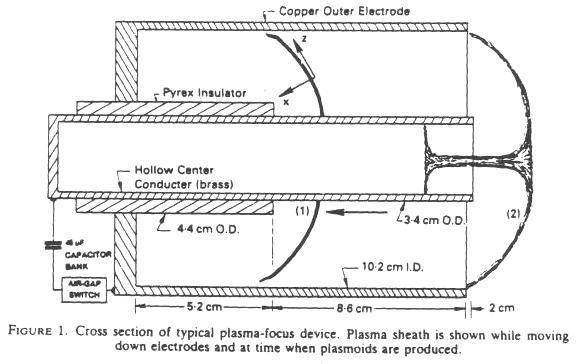Focus Fusion
Focus Fusion is projected to be a safe, clean, easy, reliable energy solution that could provide electricity at a few tenths of a cent per kilowatt-hour.
Purports to be a far more feasible and profoundly less expensive approach to hot fusion, in contrast to what the international project (ITER) in France is pursuing. Lawrenceville Plasma Physics (LPP) is currently researching and developing the dense plasma focus (DPF) for hydrogen-boron nuclear fusion.
End product would be a 5 to 20 MW power plant the size of a gas station, which would cost between $200,000 and $300,000 to build. One person could operate two dozen such stations remotely.
On Dec. 18, 2008, LPP announced the initiation of a two-year-long experimental project to test the scientific feasibility of Focus Fusion, controlled nuclear fusion using the dense plasma focus (DPF) device and hydrogen-boron fuel. Hydrogen-boron fuel produces almost no neutrons and allows the direct conversion of energy into electricity. The goals of the experiment are first, to confirm the achievement the high temperatures first observed in previous experiments at Texas A&M University; second, to greatly increase the efficiency of energy transfer into the tiny plasmoid where the fusion reactions take place; third, to achieve the high magnetic fields needed for the quantum magnetic field effect which will reduce cooling of the plasma by X-ray emission; and finally, to use hydrogen-boron fuel to demonstrate greater fusion energy production than energy fed into the plasma (positive net energy production). [1]
The basic technology of LPP’s approach is covered by US Patent 7,482,607.
Official Websites
LawrencevillePlasmaPhysics.com
- http://www.lawrencevilleplasmaphysics.com/ - Company website. Lawrenceville Plasma Physics, Inc. founded in 1974.
FocusFusion.org
- http://www.focusfusion.org - (non-profit, educational website)
A group of scientists in New Jersey claim to have made a breakthrough that would bring mankind closer to creating fusion energy on Earth -- a type of energy that the sun has been producing for billions of years. Traditionally considered a Holy Grail of science -- could plasma fusion finally become a reality? RT's Anastasia Churkina was the first reporter to access the laboratory. (YouTube / RTAmerica; April 20, 2012)
BSTRACT (from video posting)
|
To bring the whole of humanity up to the living standards of the developed world ... all requires a new source of energy that is clean, inexhaustible and much cheaper than any existing source -- fossil, nuclear, solar or wind. Fusion with hydrogen-boron fuel, which allows direct conversion of fusion energy to electricity, can be that source. It could cut energy costs more than ten-fold. It produces no radioactive waste and would be safe enough to situate in residential neighborhoods.
Of the three approaches to achieving hydrogen-boron fusion, focus fusion, using the dense plasma focus device, has experimentally achieved conditions that are closest to those needed for net power generation. It is the only approach that can utilize the high magnetic field effect, which reduces the cooling of plasma by x-rays, helping to achieve the multi-billion-degree temperatures needed for fusion. A currently-planned three-year, $2 million experiment, if funded, can demonstrate the scientific feasibility of focus fusion.
This presentation will review the history and status of focus fusion
and briefly compare it to the two competing approaches, Field Reversed
Configuration (recently funded by Paul Allen) and Inertial Electrostatic
Confinement, championed by Dr. Robert Bussard, a recent Google Tech Talk
speaker.
Attributes
- Clean
- No emissions
- No residual radiation
- Few tenths of a cent per kilowatt-hour
- Small footprint
- Input fuel is readily available and barely used
- 5-20 MW plant would cost around $200,000 to $300,000
- Applications
- Ideal for larger applications
- Suitable as a primary grid power source
- Modular
- Superior performance in use for thrust in space travel
- With additional engineering, could be applied to smaller applications
- Ease of use
- Start-up/shut-down time is near instantaneous
- No water-steam-turbine cycle required
- Direct to electricity
- Very low maintenance
- Very low operation personnel involvement
- Safe
- Operators not exposed to radiation threat
- No chance for explosion
- No possibility of melt-down
- Cannot be turned into a WMD
- Credibility
- Initial funding came from NASA/JPL
- Research accomplished at universities
- Published in peer-reviewed journals
- Receives highest recommendation from seasoned energy professional, Tom Valone (Video)
How it Works

Comparison of Focus Fusion to the Tokamak
www.pureenergysystems.com
PES Network, Inc.
Copyright © 2003 - 2012